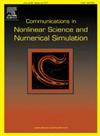用随机特征模型求解偏微分方程
IF 3.8
2区 数学
Q1 MATHEMATICS, APPLIED
Communications in Nonlinear Science and Numerical Simulation
Pub Date : 2025-09-20
DOI:10.1016/j.cnsns.2025.109343
引用次数: 0
摘要
基于机器学习的偏微分方程(PDEs)求解器近年来受到了广泛的关注。该领域的大多数进展都是由深度神经网络驱动的,如物理信息神经网络(pinn)和核方法。在本文中,我们引入了一个基于随机特征的框架来高效求解偏微分方程。随机特征方法最初是为了逼近大型核机而提出的,也可以看作是一种浅层神经网络。我们对我们提出的方法进行了误差分析,并在几个PDE基准测试中提供了全面的数值结果。与当前最先进的求解器面临大量并置点的挑战相比,我们提出的方法降低了计算复杂度。此外,我们的方法实现简单,不需要额外的计算资源。由于理论保证和计算优势,我们的方法被证明是求解偏微分方程的有效方法。本文章由计算机程序翻译,如有差异,请以英文原文为准。
Solving partial differential equations with random feature models
Machine learning based partial differential equations (PDEs) solvers have received great attention in recent years. Most progress in this area has been driven by deep neural networks such as physics-informed neural networks (PINNs) and kernel method. In this paper, we introduce a random feature based framework toward efficiently solving PDEs. Random feature method was originally proposed to approximate large-scale kernel machines and can be viewed as a shallow neural network as well. We provide an error analysis for our proposed method along with comprehensive numerical results on several PDE benchmarks. In contrast to the state-of-the-art solvers that face challenges with a large number of collocation points, our proposed method reduces the computational complexity. Moreover, the implementation of our method is simple and does not require additional computational resources. Due to the theoretical guarantee and advantages in computation, our approach is proven to be efficient for solving PDEs.
求助全文
通过发布文献求助,成功后即可免费获取论文全文。
去求助
来源期刊

Communications in Nonlinear Science and Numerical Simulation
MATHEMATICS, APPLIED-MATHEMATICS, INTERDISCIPLINARY APPLICATIONS
CiteScore
6.80
自引率
7.70%
发文量
378
审稿时长
78 days
期刊介绍:
The journal publishes original research findings on experimental observation, mathematical modeling, theoretical analysis and numerical simulation, for more accurate description, better prediction or novel application, of nonlinear phenomena in science and engineering. It offers a venue for researchers to make rapid exchange of ideas and techniques in nonlinear science and complexity.
The submission of manuscripts with cross-disciplinary approaches in nonlinear science and complexity is particularly encouraged.
Topics of interest:
Nonlinear differential or delay equations, Lie group analysis and asymptotic methods, Discontinuous systems, Fractals, Fractional calculus and dynamics, Nonlinear effects in quantum mechanics, Nonlinear stochastic processes, Experimental nonlinear science, Time-series and signal analysis, Computational methods and simulations in nonlinear science and engineering, Control of dynamical systems, Synchronization, Lyapunov analysis, High-dimensional chaos and turbulence, Chaos in Hamiltonian systems, Integrable systems and solitons, Collective behavior in many-body systems, Biological physics and networks, Nonlinear mechanical systems, Complex systems and complexity.
No length limitation for contributions is set, but only concisely written manuscripts are published. Brief papers are published on the basis of Rapid Communications. Discussions of previously published papers are welcome.
 求助内容:
求助内容: 应助结果提醒方式:
应助结果提醒方式:


